Entrepreneurial Growth: Addressing Challenges and Exit Strategies
VerifiedAdded on 2020/05/11
|6
|1654
|140
Essay
AI Summary
This essay is a reflection on the challenges of entrepreneurial growth, focusing on the importance of understanding customer needs and adapting to market demands. It explores how organizational structures and corporate governance can address these challenges, emphasizing the transition from an unplanned to a more disciplined business entity. The essay discusses the need for clear job roles, effective control systems, and professional management to navigate the growth phases. It also examines the benefits and drawbacks of different exit strategies, such as acquisitions and splits, and highlights the role of corporate governance in securing capital and rewarding investors. The author reflects on the critical factors influencing entrepreneurial activities and the importance of strategic planning and organizational development for long-term success. The essay draws upon several academic sources to support its arguments.

Running head: ENTREPRENEURIAL GROWTH
Entrepreneurial Growth
Name of Student
Name of the University
Author Note
Entrepreneurial Growth
Name of Student
Name of the University
Author Note
Paraphrase This Document
Need a fresh take? Get an instant paraphrase of this document with our AI Paraphraser
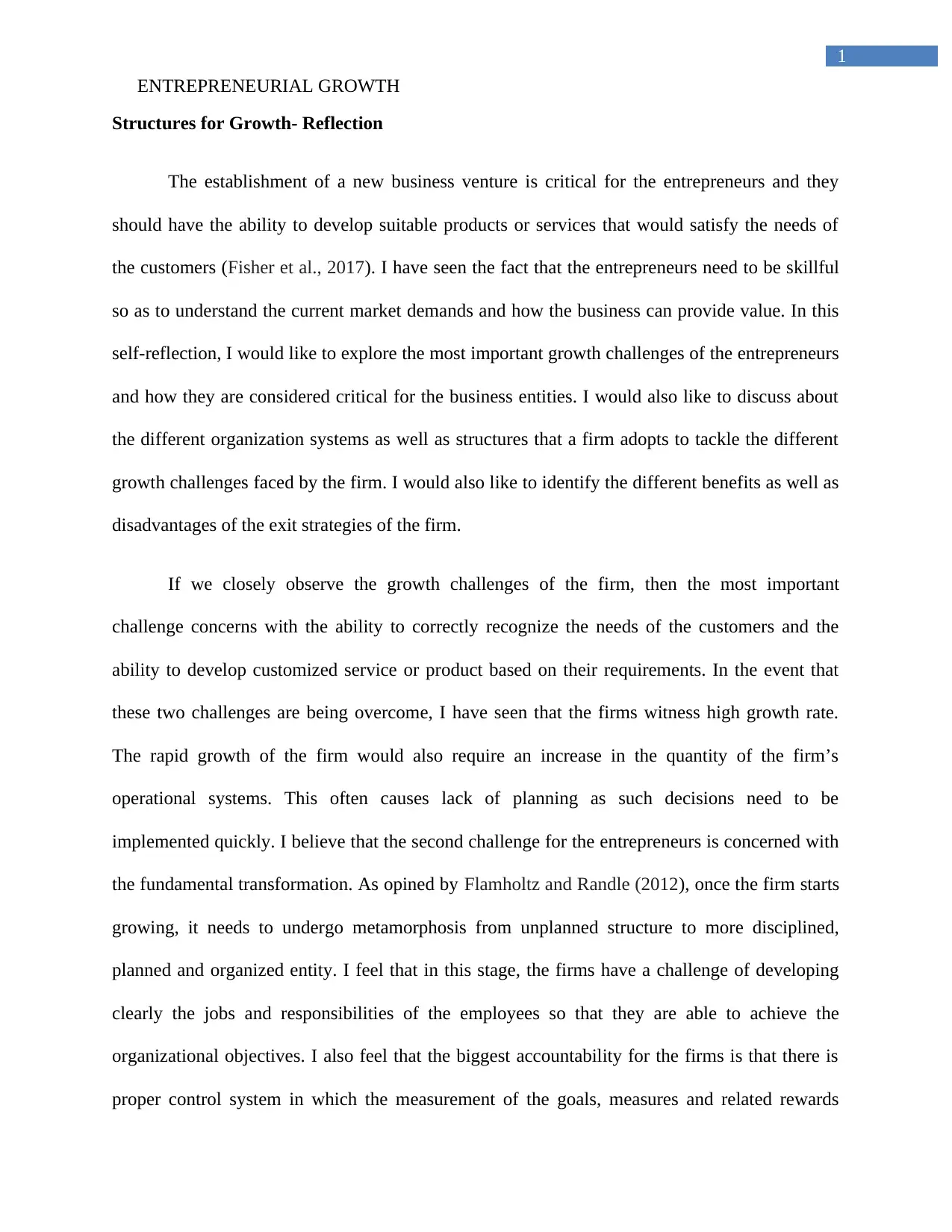
1
ENTREPRENEURIAL GROWTH
Structures for Growth- Reflection
The establishment of a new business venture is critical for the entrepreneurs and they
should have the ability to develop suitable products or services that would satisfy the needs of
the customers (Fisher et al., 2017). I have seen the fact that the entrepreneurs need to be skillful
so as to understand the current market demands and how the business can provide value. In this
self-reflection, I would like to explore the most important growth challenges of the entrepreneurs
and how they are considered critical for the business entities. I would also like to discuss about
the different organization systems as well as structures that a firm adopts to tackle the different
growth challenges faced by the firm. I would also like to identify the different benefits as well as
disadvantages of the exit strategies of the firm.
If we closely observe the growth challenges of the firm, then the most important
challenge concerns with the ability to correctly recognize the needs of the customers and the
ability to develop customized service or product based on their requirements. In the event that
these two challenges are being overcome, I have seen that the firms witness high growth rate.
The rapid growth of the firm would also require an increase in the quantity of the firm’s
operational systems. This often causes lack of planning as such decisions need to be
implemented quickly. I believe that the second challenge for the entrepreneurs is concerned with
the fundamental transformation. As opined by Flamholtz and Randle (2012), once the firm starts
growing, it needs to undergo metamorphosis from unplanned structure to more disciplined,
planned and organized entity. I feel that in this stage, the firms have a challenge of developing
clearly the jobs and responsibilities of the employees so that they are able to achieve the
organizational objectives. I also feel that the biggest accountability for the firms is that there is
proper control system in which the measurement of the goals, measures and related rewards
ENTREPRENEURIAL GROWTH
Structures for Growth- Reflection
The establishment of a new business venture is critical for the entrepreneurs and they
should have the ability to develop suitable products or services that would satisfy the needs of
the customers (Fisher et al., 2017). I have seen the fact that the entrepreneurs need to be skillful
so as to understand the current market demands and how the business can provide value. In this
self-reflection, I would like to explore the most important growth challenges of the entrepreneurs
and how they are considered critical for the business entities. I would also like to discuss about
the different organization systems as well as structures that a firm adopts to tackle the different
growth challenges faced by the firm. I would also like to identify the different benefits as well as
disadvantages of the exit strategies of the firm.
If we closely observe the growth challenges of the firm, then the most important
challenge concerns with the ability to correctly recognize the needs of the customers and the
ability to develop customized service or product based on their requirements. In the event that
these two challenges are being overcome, I have seen that the firms witness high growth rate.
The rapid growth of the firm would also require an increase in the quantity of the firm’s
operational systems. This often causes lack of planning as such decisions need to be
implemented quickly. I believe that the second challenge for the entrepreneurs is concerned with
the fundamental transformation. As opined by Flamholtz and Randle (2012), once the firm starts
growing, it needs to undergo metamorphosis from unplanned structure to more disciplined,
planned and organized entity. I feel that in this stage, the firms have a challenge of developing
clearly the jobs and responsibilities of the employees so that they are able to achieve the
organizational objectives. I also feel that the biggest accountability for the firms is that there is
proper control system in which the measurement of the goals, measures and related rewards
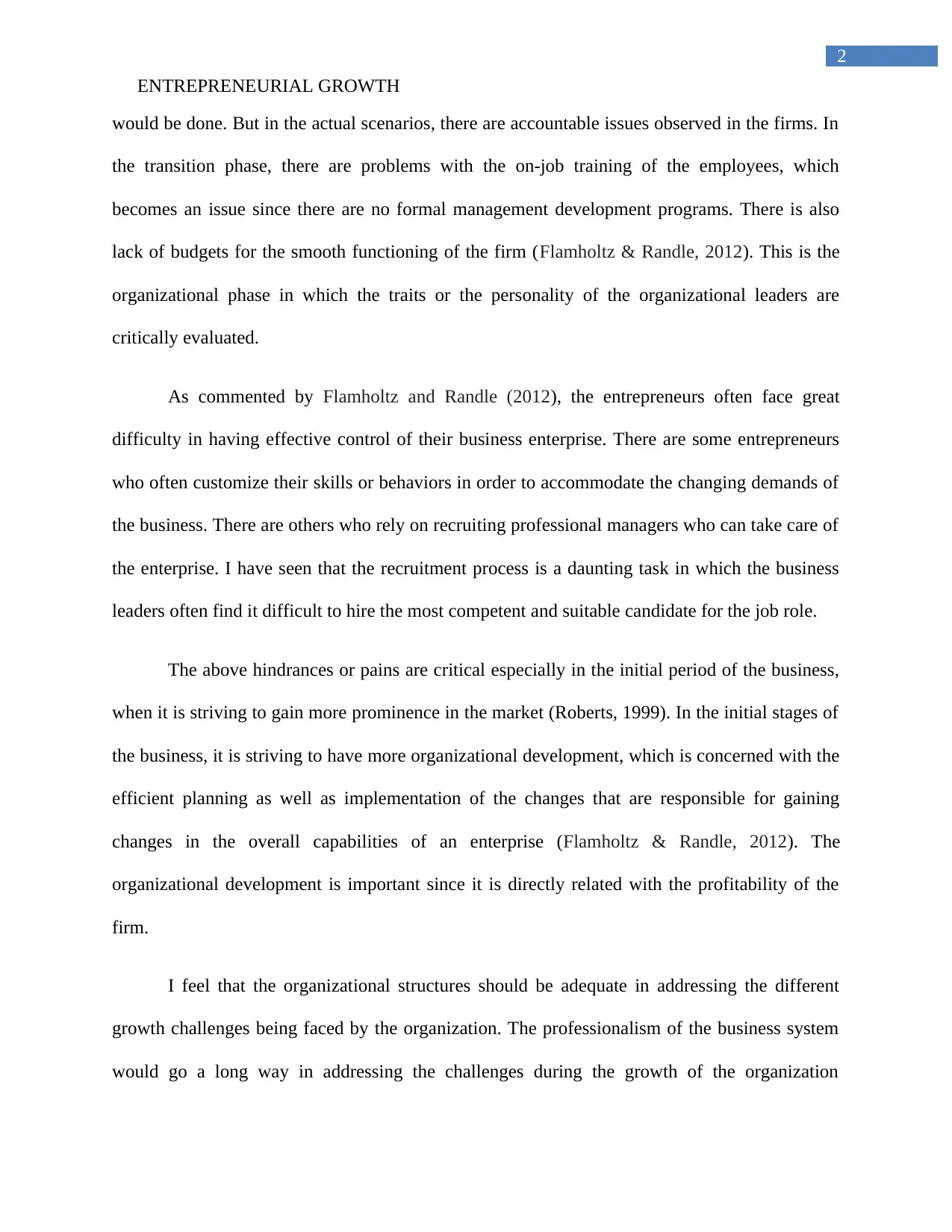
2
ENTREPRENEURIAL GROWTH
would be done. But in the actual scenarios, there are accountable issues observed in the firms. In
the transition phase, there are problems with the on-job training of the employees, which
becomes an issue since there are no formal management development programs. There is also
lack of budgets for the smooth functioning of the firm (Flamholtz & Randle, 2012). This is the
organizational phase in which the traits or the personality of the organizational leaders are
critically evaluated.
As commented by Flamholtz and Randle (2012), the entrepreneurs often face great
difficulty in having effective control of their business enterprise. There are some entrepreneurs
who often customize their skills or behaviors in order to accommodate the changing demands of
the business. There are others who rely on recruiting professional managers who can take care of
the enterprise. I have seen that the recruitment process is a daunting task in which the business
leaders often find it difficult to hire the most competent and suitable candidate for the job role.
The above hindrances or pains are critical especially in the initial period of the business,
when it is striving to gain more prominence in the market (Roberts, 1999). In the initial stages of
the business, it is striving to have more organizational development, which is concerned with the
efficient planning as well as implementation of the changes that are responsible for gaining
changes in the overall capabilities of an enterprise (Flamholtz & Randle, 2012). The
organizational development is important since it is directly related with the profitability of the
firm.
I feel that the organizational structures should be adequate in addressing the different
growth challenges being faced by the organization. The professionalism of the business system
would go a long way in addressing the challenges during the growth of the organization
ENTREPRENEURIAL GROWTH
would be done. But in the actual scenarios, there are accountable issues observed in the firms. In
the transition phase, there are problems with the on-job training of the employees, which
becomes an issue since there are no formal management development programs. There is also
lack of budgets for the smooth functioning of the firm (Flamholtz & Randle, 2012). This is the
organizational phase in which the traits or the personality of the organizational leaders are
critically evaluated.
As commented by Flamholtz and Randle (2012), the entrepreneurs often face great
difficulty in having effective control of their business enterprise. There are some entrepreneurs
who often customize their skills or behaviors in order to accommodate the changing demands of
the business. There are others who rely on recruiting professional managers who can take care of
the enterprise. I have seen that the recruitment process is a daunting task in which the business
leaders often find it difficult to hire the most competent and suitable candidate for the job role.
The above hindrances or pains are critical especially in the initial period of the business,
when it is striving to gain more prominence in the market (Roberts, 1999). In the initial stages of
the business, it is striving to have more organizational development, which is concerned with the
efficient planning as well as implementation of the changes that are responsible for gaining
changes in the overall capabilities of an enterprise (Flamholtz & Randle, 2012). The
organizational development is important since it is directly related with the profitability of the
firm.
I feel that the organizational structures should be adequate in addressing the different
growth challenges being faced by the organization. The professionalism of the business system
would go a long way in addressing the challenges during the growth of the organization
⊘ This is a preview!⊘
Do you want full access?
Subscribe today to unlock all pages.

Trusted by 1+ million students worldwide
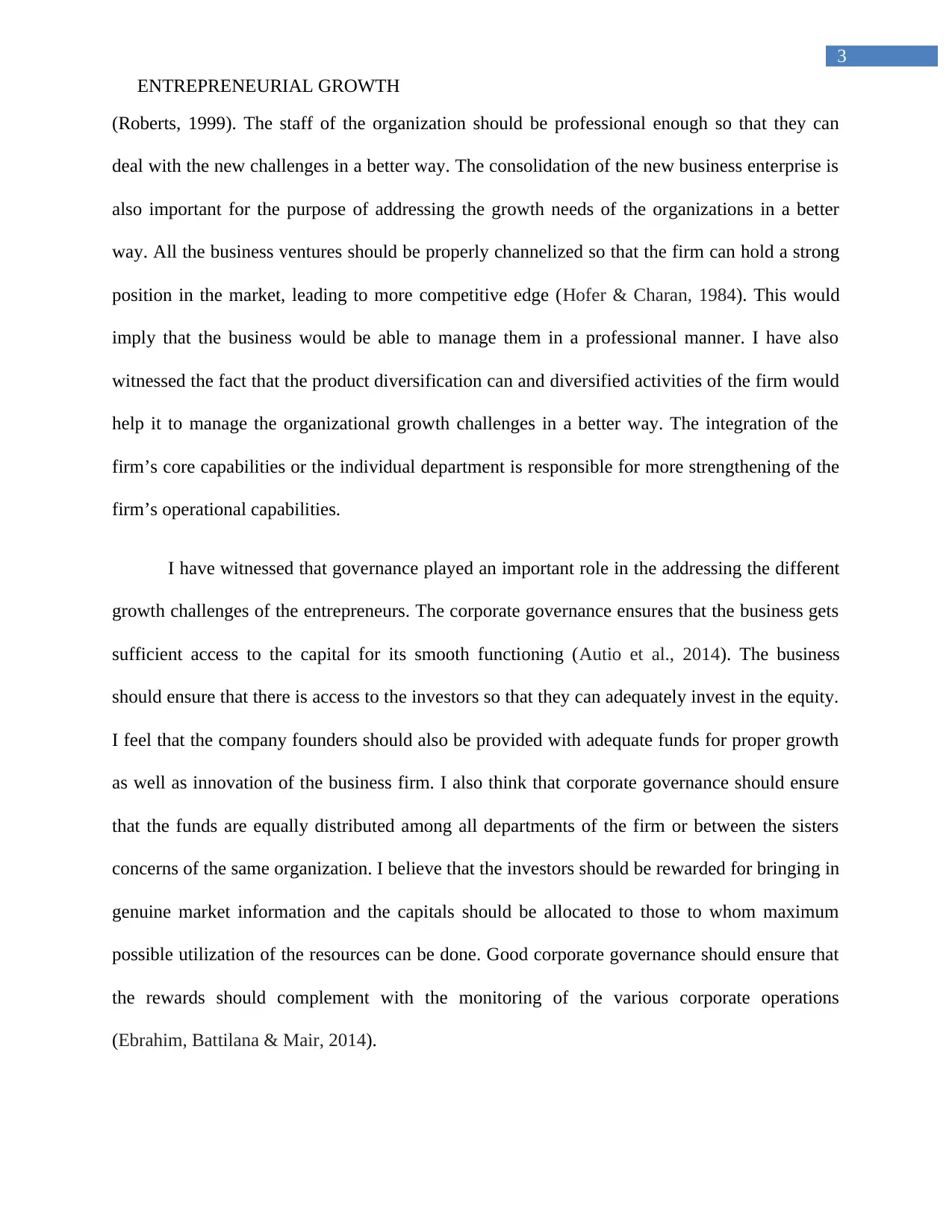
3
ENTREPRENEURIAL GROWTH
(Roberts, 1999). The staff of the organization should be professional enough so that they can
deal with the new challenges in a better way. The consolidation of the new business enterprise is
also important for the purpose of addressing the growth needs of the organizations in a better
way. All the business ventures should be properly channelized so that the firm can hold a strong
position in the market, leading to more competitive edge (Hofer & Charan, 1984). This would
imply that the business would be able to manage them in a professional manner. I have also
witnessed the fact that the product diversification can and diversified activities of the firm would
help it to manage the organizational growth challenges in a better way. The integration of the
firm’s core capabilities or the individual department is responsible for more strengthening of the
firm’s operational capabilities.
I have witnessed that governance played an important role in the addressing the different
growth challenges of the entrepreneurs. The corporate governance ensures that the business gets
sufficient access to the capital for its smooth functioning (Autio et al., 2014). The business
should ensure that there is access to the investors so that they can adequately invest in the equity.
I feel that the company founders should also be provided with adequate funds for proper growth
as well as innovation of the business firm. I also think that corporate governance should ensure
that the funds are equally distributed among all departments of the firm or between the sisters
concerns of the same organization. I believe that the investors should be rewarded for bringing in
genuine market information and the capitals should be allocated to those to whom maximum
possible utilization of the resources can be done. Good corporate governance should ensure that
the rewards should complement with the monitoring of the various corporate operations
(Ebrahim, Battilana & Mair, 2014).
ENTREPRENEURIAL GROWTH
(Roberts, 1999). The staff of the organization should be professional enough so that they can
deal with the new challenges in a better way. The consolidation of the new business enterprise is
also important for the purpose of addressing the growth needs of the organizations in a better
way. All the business ventures should be properly channelized so that the firm can hold a strong
position in the market, leading to more competitive edge (Hofer & Charan, 1984). This would
imply that the business would be able to manage them in a professional manner. I have also
witnessed the fact that the product diversification can and diversified activities of the firm would
help it to manage the organizational growth challenges in a better way. The integration of the
firm’s core capabilities or the individual department is responsible for more strengthening of the
firm’s operational capabilities.
I have witnessed that governance played an important role in the addressing the different
growth challenges of the entrepreneurs. The corporate governance ensures that the business gets
sufficient access to the capital for its smooth functioning (Autio et al., 2014). The business
should ensure that there is access to the investors so that they can adequately invest in the equity.
I feel that the company founders should also be provided with adequate funds for proper growth
as well as innovation of the business firm. I also think that corporate governance should ensure
that the funds are equally distributed among all departments of the firm or between the sisters
concerns of the same organization. I believe that the investors should be rewarded for bringing in
genuine market information and the capitals should be allocated to those to whom maximum
possible utilization of the resources can be done. Good corporate governance should ensure that
the rewards should complement with the monitoring of the various corporate operations
(Ebrahim, Battilana & Mair, 2014).
Paraphrase This Document
Need a fresh take? Get an instant paraphrase of this document with our AI Paraphraser
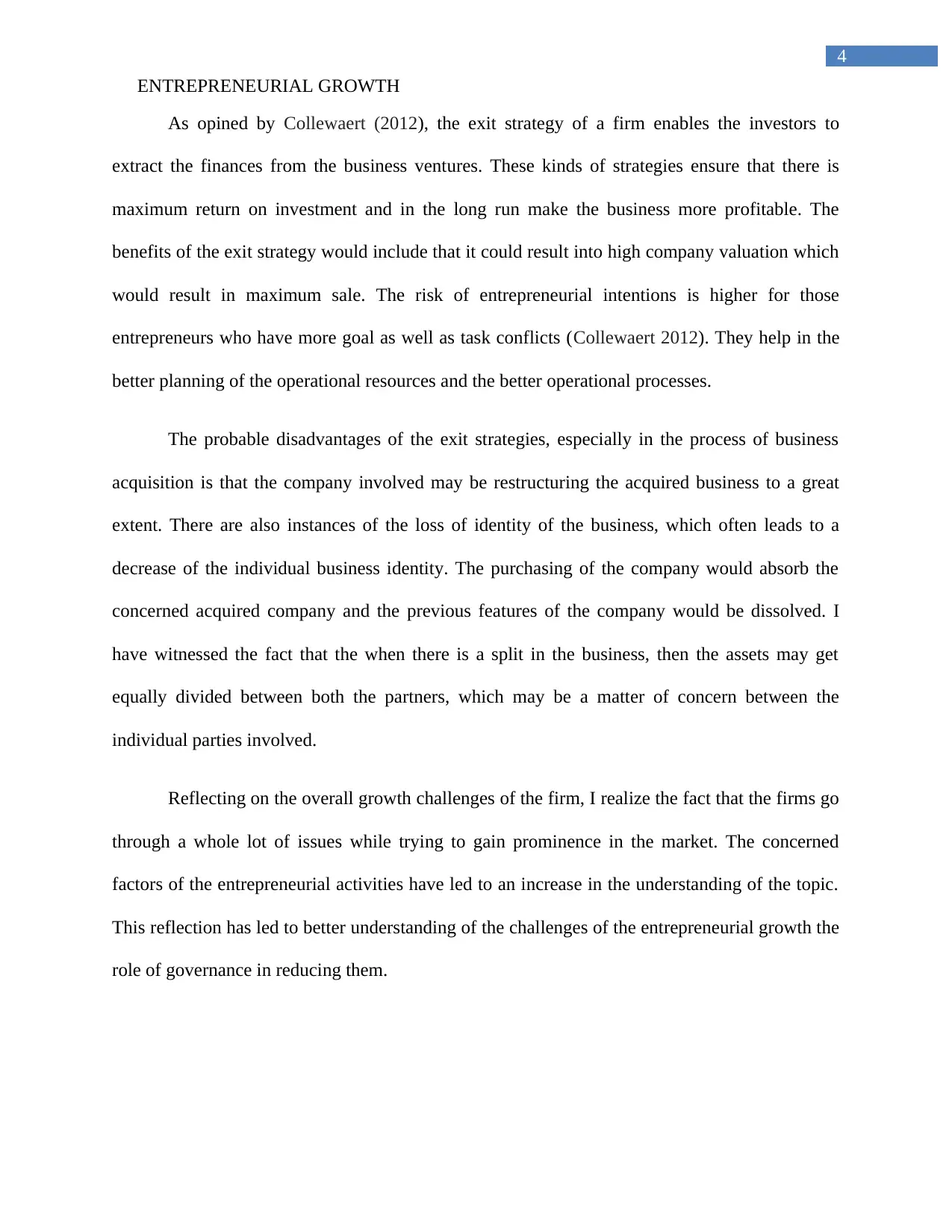
4
ENTREPRENEURIAL GROWTH
As opined by Collewaert (2012), the exit strategy of a firm enables the investors to
extract the finances from the business ventures. These kinds of strategies ensure that there is
maximum return on investment and in the long run make the business more profitable. The
benefits of the exit strategy would include that it could result into high company valuation which
would result in maximum sale. The risk of entrepreneurial intentions is higher for those
entrepreneurs who have more goal as well as task conflicts (Collewaert 2012). They help in the
better planning of the operational resources and the better operational processes.
The probable disadvantages of the exit strategies, especially in the process of business
acquisition is that the company involved may be restructuring the acquired business to a great
extent. There are also instances of the loss of identity of the business, which often leads to a
decrease of the individual business identity. The purchasing of the company would absorb the
concerned acquired company and the previous features of the company would be dissolved. I
have witnessed the fact that the when there is a split in the business, then the assets may get
equally divided between both the partners, which may be a matter of concern between the
individual parties involved.
Reflecting on the overall growth challenges of the firm, I realize the fact that the firms go
through a whole lot of issues while trying to gain prominence in the market. The concerned
factors of the entrepreneurial activities have led to an increase in the understanding of the topic.
This reflection has led to better understanding of the challenges of the entrepreneurial growth the
role of governance in reducing them.
ENTREPRENEURIAL GROWTH
As opined by Collewaert (2012), the exit strategy of a firm enables the investors to
extract the finances from the business ventures. These kinds of strategies ensure that there is
maximum return on investment and in the long run make the business more profitable. The
benefits of the exit strategy would include that it could result into high company valuation which
would result in maximum sale. The risk of entrepreneurial intentions is higher for those
entrepreneurs who have more goal as well as task conflicts (Collewaert 2012). They help in the
better planning of the operational resources and the better operational processes.
The probable disadvantages of the exit strategies, especially in the process of business
acquisition is that the company involved may be restructuring the acquired business to a great
extent. There are also instances of the loss of identity of the business, which often leads to a
decrease of the individual business identity. The purchasing of the company would absorb the
concerned acquired company and the previous features of the company would be dissolved. I
have witnessed the fact that the when there is a split in the business, then the assets may get
equally divided between both the partners, which may be a matter of concern between the
individual parties involved.
Reflecting on the overall growth challenges of the firm, I realize the fact that the firms go
through a whole lot of issues while trying to gain prominence in the market. The concerned
factors of the entrepreneurial activities have led to an increase in the understanding of the topic.
This reflection has led to better understanding of the challenges of the entrepreneurial growth the
role of governance in reducing them.
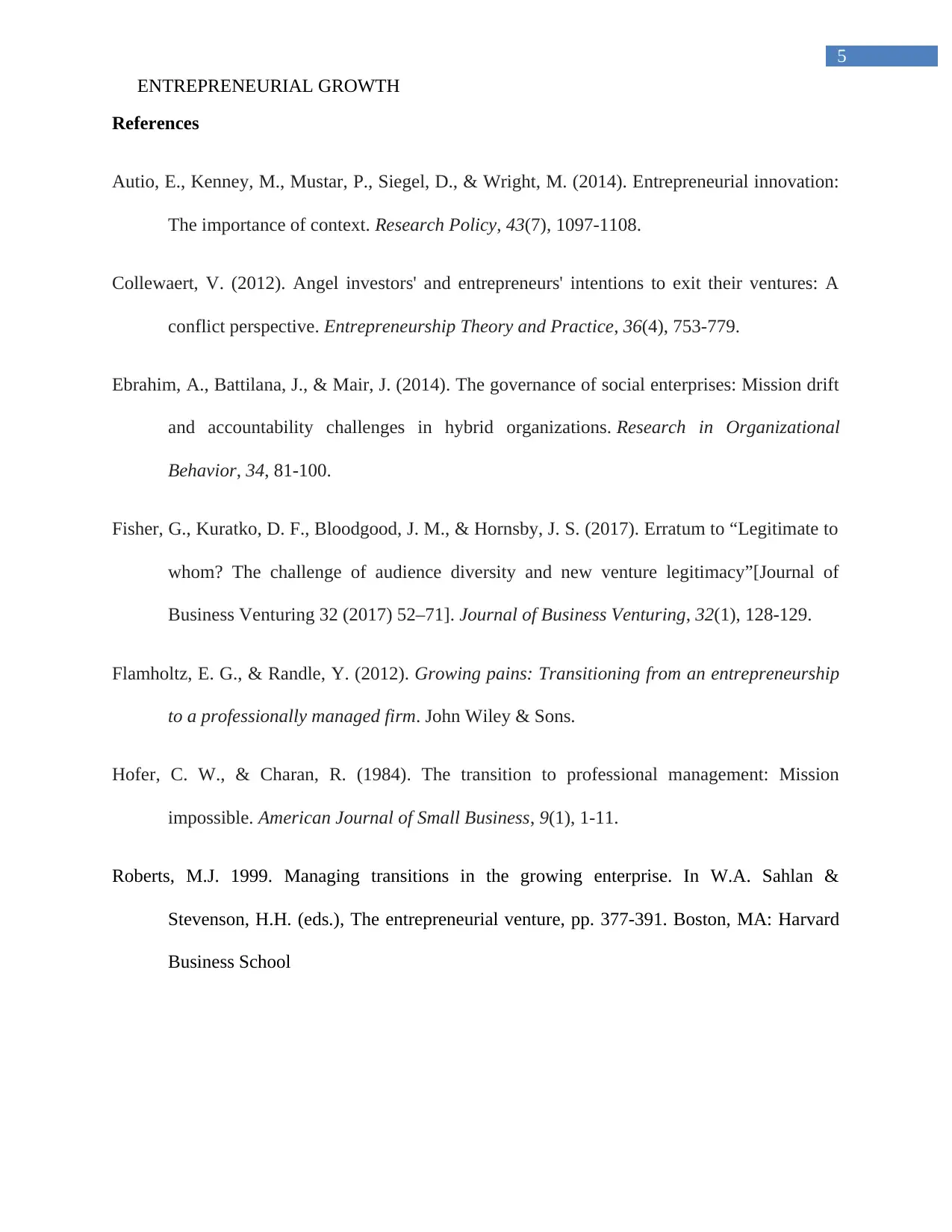
5
ENTREPRENEURIAL GROWTH
References
Autio, E., Kenney, M., Mustar, P., Siegel, D., & Wright, M. (2014). Entrepreneurial innovation:
The importance of context. Research Policy, 43(7), 1097-1108.
Collewaert, V. (2012). Angel investors' and entrepreneurs' intentions to exit their ventures: A
conflict perspective. Entrepreneurship Theory and Practice, 36(4), 753-779.
Ebrahim, A., Battilana, J., & Mair, J. (2014). The governance of social enterprises: Mission drift
and accountability challenges in hybrid organizations. Research in Organizational
Behavior, 34, 81-100.
Fisher, G., Kuratko, D. F., Bloodgood, J. M., & Hornsby, J. S. (2017). Erratum to “Legitimate to
whom? The challenge of audience diversity and new venture legitimacy”[Journal of
Business Venturing 32 (2017) 52–71]. Journal of Business Venturing, 32(1), 128-129.
Flamholtz, E. G., & Randle, Y. (2012). Growing pains: Transitioning from an entrepreneurship
to a professionally managed firm. John Wiley & Sons.
Hofer, C. W., & Charan, R. (1984). The transition to professional management: Mission
impossible. American Journal of Small Business, 9(1), 1-11.
Roberts, M.J. 1999. Managing transitions in the growing enterprise. In W.A. Sahlan &
Stevenson, H.H. (eds.), The entrepreneurial venture, pp. 377-391. Boston, MA: Harvard
Business School
ENTREPRENEURIAL GROWTH
References
Autio, E., Kenney, M., Mustar, P., Siegel, D., & Wright, M. (2014). Entrepreneurial innovation:
The importance of context. Research Policy, 43(7), 1097-1108.
Collewaert, V. (2012). Angel investors' and entrepreneurs' intentions to exit their ventures: A
conflict perspective. Entrepreneurship Theory and Practice, 36(4), 753-779.
Ebrahim, A., Battilana, J., & Mair, J. (2014). The governance of social enterprises: Mission drift
and accountability challenges in hybrid organizations. Research in Organizational
Behavior, 34, 81-100.
Fisher, G., Kuratko, D. F., Bloodgood, J. M., & Hornsby, J. S. (2017). Erratum to “Legitimate to
whom? The challenge of audience diversity and new venture legitimacy”[Journal of
Business Venturing 32 (2017) 52–71]. Journal of Business Venturing, 32(1), 128-129.
Flamholtz, E. G., & Randle, Y. (2012). Growing pains: Transitioning from an entrepreneurship
to a professionally managed firm. John Wiley & Sons.
Hofer, C. W., & Charan, R. (1984). The transition to professional management: Mission
impossible. American Journal of Small Business, 9(1), 1-11.
Roberts, M.J. 1999. Managing transitions in the growing enterprise. In W.A. Sahlan &
Stevenson, H.H. (eds.), The entrepreneurial venture, pp. 377-391. Boston, MA: Harvard
Business School
⊘ This is a preview!⊘
Do you want full access?
Subscribe today to unlock all pages.

Trusted by 1+ million students worldwide
1 out of 6
Related Documents
Your All-in-One AI-Powered Toolkit for Academic Success.
+13062052269
info@desklib.com
Available 24*7 on WhatsApp / Email
![[object Object]](/_next/static/media/star-bottom.7253800d.svg)
Unlock your academic potential
Copyright © 2020–2025 A2Z Services. All Rights Reserved. Developed and managed by ZUCOL.




